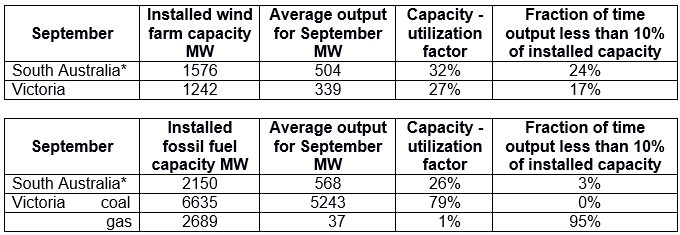The government of Victoria has a target of 40% renewable electricity by 2025. This would require the construction of new wind farms with a total capacity of some 7000 to 8000 MW. A more modest approach is taken here by analyzing the consequences of an extra 4000 MW of wind power, about the equivalent of removing the Hazelwood power station, and looking at what might happen following the example of South Australia.
There are two difficulties, intermittency and the same winds blowing across state borders causing correlated variations in the supply of wind power.
Victorian generators are presently supplying the balancing power to the South Australian electricity market with as much as 800 MW and in return very occasionally South Australian wind farms send their surplus back to Victoria. This can be seen in Figure 1 where the two interconnectors, Heywood and Murraylink, can be seen supplying power when there is little wind in South Australia.
Advertisement

Figure 1: 30 minute supply from South Australian wind farms and two Victorian interconnectors, Heywood (600 MW) and Murraylink (200 MW), for part of September 2016. At times, usually in the early morning, wind power is sent into the Victorian electricity market (as shown by the negative-going excursions in the Heywood and Murraylink curves above).
There is a clear correlation of wind farm output between South Australia and Victoria. In statistical terms it is 40% and given the already wide geographical spread of the present wind farms in Victoria then building more there should not make a significant difference to this correlation.

Figure 2:30 minute wind farm power output for September 2016 for South Australia with 1576 MW of installed capacity, and Victoria with 1242 MW of installed capacity.
So if Victoria increases its wind farm capacity what might be expected for the physical and economic performance of coal burning base load power stations?
Advertisement
Firstly, the present performance, shown in the table below, indicates that wind farms generate on average only some 30% of their rated capacity and even this value varies through the year. Secondly, the fossil fuel using generators have a very different utilisation in South Australia compared to Victoria. Base load generators that deliver low cost power need to operate for most of the time and this is the case for Victoria. But the large supply of power from wind farms has destroyed the ability of the gas fed generators in South Australia to act as base load suppliers of power and so require higher prices for the delivery of power.

* all gas fossil fuels from 1 to 27 September
Discuss in our Forums
See what other readers are saying about this article!
Click here to read & post comments.
23 posts so far.